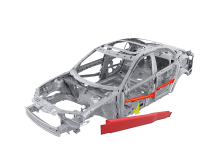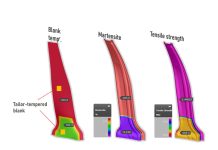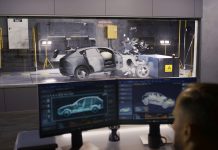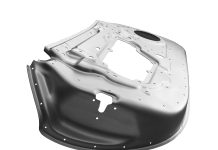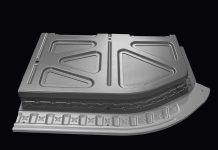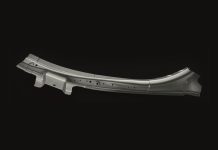Do You Really Need to Account for Phase Changes
During Warm & Hot Forming of Aluminum?
One of the numerous topics discussed at the CHS2 conference in Atlanta in June of this year was the warm- and hotforming of aluminum alloys. Collaborations with influential customers dealing with a widespread variety of aluminum alloys and processes have given us a good understanding of the involved challenges which we want to share in this blog post. We frequently experience an uncertainty in the forming community understanding the capabilities of forming simulation software with respect to aluminum alloys.
So, first of all: aluminum is not steel and does not at all behave like steel! While multiple phase transformation-effects form the basis for the PHS-technology, aluminum alloys do not offer such different temperature depended base phases. So, no effect can be generated from that – which could be used to design final part properties just by forming and quenching afterwards. Depending on the alloy type, strength and hardness are simply generated by diffusion driven precipitation processes of intermetallic phases formed by aluminum and its principal alloying elements. When these ageing processes are carried out, this usually occurs after the stamping process – as is typical for hotforming of aluminum alloys. During forming itself, the material arrives in a solution treated state – meaning the alloying elements are solved in the base aluminum matrix. Only fine precipitates are distributed homogenously in the grains. In this stage, the material displays excellent formability – while the separate ageing process afterwards ensures the desired mechanical properties of the final part. In case of warmforming the aluminum material is used in its almost final conditions. Rolling, solution treatment and aging for setting up intermediate material properties for subsequent forming operations have been carried out. The warmforming process itself generates the final state of material properties.

Successful simulation of a hotforming process using Constellium Ultralex®
Now what defines whether we talk about warmforming or hotforming? And, what difference does that make in the case of aluminum stamping?
There is a rule of thumb saying that temperatures above 40 to 50% of the melting temperature are considered hotforming. Warmforming means that thermal energy has been introduced to the forming operation but no recrystallization occurs. Specifically these recrystallization processes generally characterize a hotforming process. Recrystallization leads to sudden softening and stress relief due to full reorganization of the microstructure. During forming flow stresses are decreasing while material textures are being dissolved and rebuild.
Finally, the selection of the temperature-assisted forming process which should be used is not so simple. One should look a little bit further into the characteristic details of metal behavior under forming conditions. The magic word here is stacking fault energy. This concept mainly explains how much energy can be stored by disturbing the lattice structure in the grains of any metallic material. It is also linked to the value of energy that has to be introduced before any kind of reorganization occurs – even after strong deformation. Aluminum materials are characterized by high stacking fault energy values meaning that a lot of deformation and energy has to be introduced in order to trigger recrystallization. Therefore, the mentioned rule of thumb has to be corrected towards much higher temperature values for the distinction between warm- and hotforming for aluminum alloys. Furthermore, the pre-deformation strains, as the driving parameter for the initiation of recrystallization, under distinct thermal conditions, can be rather high.

Set of temperature dependent material data for
an exemplary aluminum alloy
Now let us have a look at the considered drawing process. What defines the drawability under different thermal conditions? Warm- and hotforming processes are characterized by an equilibrium of formability of the sheet material at certain temperatures and the strength needed to transmit the drawing forces in the sheet. One might believe that simply increasing the temperature leads to superior formability. However, this is not the case. A characteristic representation of real forming operations is the typical cup-drawing test. The best results are obtained when the flange area temperature- controlled by die and binder – is higher compared to the temperature of the surrounding material of the punch. This is linked to the fact that strength is needed in the cylindrical portion of the cup in order to transmit sufficient forces into to flange area for drawing. Excessive thinning in the cylindrical areas of the cup must be avoided by keeping the punch temperatures reasonably low – even during “hotforming”. This is usually proven by the thermal limiting drawing ratio. Assuming identical material properties, they reach a maximum at still moderate forming temperatures.

Numisheet 2016 – benchmark 3 – cup drawing test
What does a process look like when the forming process does not require maximum temperatures, the strains introduced to the sheets are rather low, the strain rate does not reach critical values and the treated material does not exhibit any tendency towards recrystallization? Can we really talk about hotforming – per definition – in all cases? Since predominately recovery effects are considered there is a perfect match between what is required for a simulation and what AutoForm can deliver.
The Numisheet 2016 benchmark has proven the excellent accuracy of AutoForm simulations for the warm- and hotstamping of aluminum alloys. In an exemplary cup-drawing test, applying the aluminum alloy AA5086-H111, the results were compared to measurements of cup drawing experiments. In this benchmark the AutoForm solver was proven to deliver the best performance in terms of prediction of temperature distribution in the blank, required forces for forming and local thinning. Since the tests refer to an existing material data set including temperature dependent r-values the prediction of springback is supposed to be excellent as well.
So AutoForm offers a reliable solution for solving forming obstacles with respect to the warm- and hotforming of aluminum alloys. Everyone can participate in the manifold benefits – accurate, fast, easy-to-use – of this well established and professionally supported software solution.



